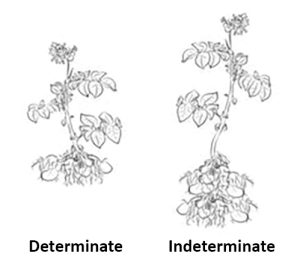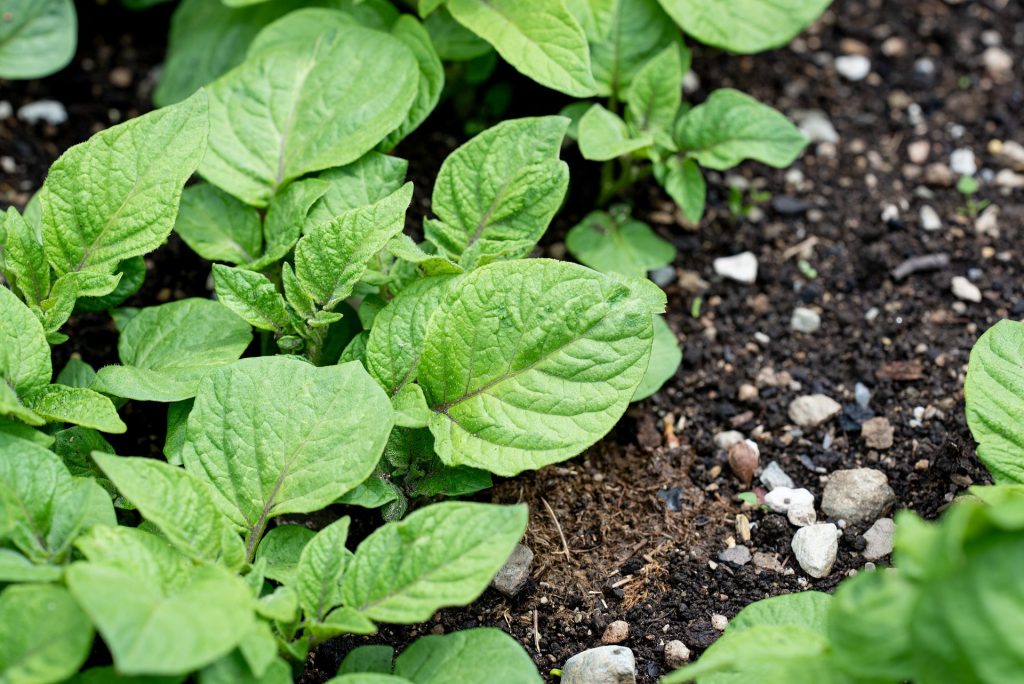Growing Potatoes
Potatoes come in two main types – determinate and indeterminate.

Determinate potatoes are varieties with tubers that grow in just one layer. For this reason, the plants do not require mounding of the soil around them. They produce in about 70 to 90 days. Varieties include Red Pontiac, Kipfler, and Pink Eye. Indeterminate potatoes grow in multiple layers, so it is important to mound soil around the plants. This will give you a better yield. Indeterminate potatoes produce in about 110 to 135 days. Varieties include Nicola, Desiree, King Edward and Dutch Cream.
Potatoes can grow well in bags and containers such as an old garbage bin or large pot.
Site and soil
Potatoes like soil that is fine and friable and well-draining. Potatoes like a sunny position. Potatoes do well in acidic soil – pH 6.0-6.5.
Plants use the nutrient phosphorus for root formation, stem growth, and fruiting, so it’s particularly important to all root crops, including potatoes. Therefore, it’s best to use a balanced fertiliser that will typically contain ample phosphorus and provide all necessary nutrients in the right amounts. Fertilisers such as chicken manure or blood & bone are particularly phosphorus-rich and are great for use around root crops such as potatoes.
Planting
Seed potatoes can be sown from September, or about a month before the expected last frost, through to December.
Do not plant where potatoes or tomatoes have been grown in the past year (check crop rotation guides for other crops).
Sow in furrows 10 cm deep, 25 cm between tubers and 75 cm between rows. Place the potato eye where the tuber is growing facing upwards. Sprinkle with a complete fertiliser, preferably high in phosphorous on each side of the potato, using 30 g per plant.
Direct planting into roughly prepared soil is most effective, with seeds sown at a depth of 5-10 cm, with 15-20 cm between plants and 70 cm between rows.

Cultivating
Keep the soil consistently moist (but not wet) during growth and mulch heavily.
Determinate potatoes are fast-growing varieties with tubers that grow in just one layer – at the soil depth just above where the seed was planted. For this reason, the plants do not require mounding or hilling of the soil around them. If conditions are right, these potatoes set one layer of stolon growth that moves outward and produces up to 8 tubers. Sow determinate potatoes in loose soil to a depth of about four inches (10 cm.). Use mulch to prevent weed growth and to prevent the tubers from being exposed to the sun, which will turn the potatoes green.
Indeterminate potatoes grow in multiple layers with the tubers growing all along the stem where soil exists. Therefore, you need to mound the soil around the plants so you can continually cover part of the stem as it grows. This will enable the layers of potatoes to grow from the stem as the plants mature. Once the plants have grown to a height of 15-20 cm, add several inches of straw mulch, dead leaves and/or soil mix (hilling) until just 10 cm of the plant is sticking up from the mound or tower soil level. Continue to add layers of soil mix as the plant grows until it reaches a maximum of 45-60 cm. Then allow the foliage to grow and watch for the flowering stage.
Harvesting
Potatoes are ready to lift when the tops begin to die off. Depending on the variety this can be anywhere from 60-120 days from planting – check the variety and label. In practice potatoes can stay in the ground longer and you can harvest as you need. When they start to re-germinate and grow tubers it is time to stop and dig them all out.

Problems
Potatoes are susceptible to a range of fungal and other diseases. Prevention is the best cure. Use certified disease-free seed potatoes to lessen the chance of disease.